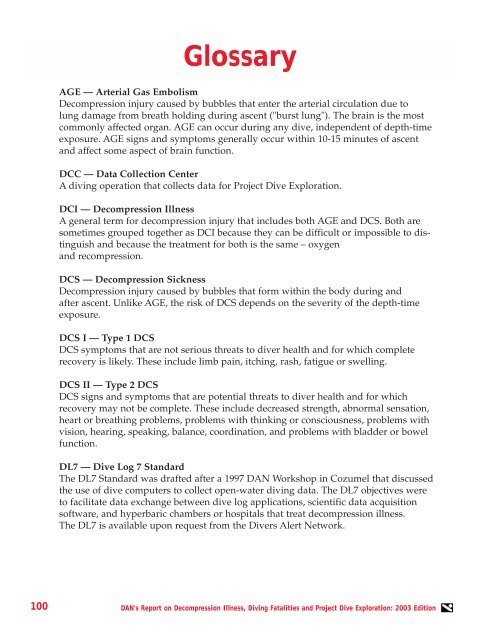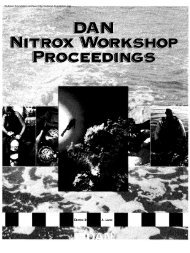Report on Decompression Illness, Diving Fatalities - Divers Alert ...
Report on Decompression Illness, Diving Fatalities - Divers Alert ...
Report on Decompression Illness, Diving Fatalities - Divers Alert ...
You also want an ePaper? Increase the reach of your titles
YUMPU automatically turns print PDFs into web optimized ePapers that Google loves.
GlossaryAGE — Arterial Gas EmbolismDecompressi<strong>on</strong> injury caused by bubbles that enter the arterial circulati<strong>on</strong> due tolung damage from breath holding during ascent ("burst lung"). The brain is the mostcomm<strong>on</strong>ly affected organ. AGE can occur during any dive, independent of depth-timeexposure. AGE signs and symptoms generally occur within 10-15 minutes of ascentand affect some aspect of brain functi<strong>on</strong>.DCC — Data Collecti<strong>on</strong> CenterA diving operati<strong>on</strong> that collects data for Project Dive Explorati<strong>on</strong>.DCI — Decompressi<strong>on</strong> <strong>Illness</strong>A general term for decompressi<strong>on</strong> injury that includes both AGE and DCS. Both aresometimes grouped together as DCI because they can be difficult or impossible to distinguishand because the treatment for both is the same – oxygenand recompressi<strong>on</strong>.DCS — Decompressi<strong>on</strong> SicknessDecompressi<strong>on</strong> injury caused by bubbles that form within the body during andafter ascent. Unlike AGE, the risk of DCS depends <strong>on</strong> the severity of the depth-timeexposure.DCS I — Type 1 DCSDCS symptoms that are not serious threats to diver health and for which completerecovery is likely. These include limb pain, itching, rash, fatigue or swelling.DCS II — Type 2 DCSDCS signs and symptoms that are potential threats to diver health and for whichrecovery may not be complete. These include decreased strength, abnormal sensati<strong>on</strong>,heart or breathing problems, problems with thinking or c<strong>on</strong>sciousness, problems withvisi<strong>on</strong>, hearing, speaking, balance, coordinati<strong>on</strong>, and problems with bladder or bowelfuncti<strong>on</strong>.DL7 — Dive Log 7 StandardThe DL7 Standard was drafted after a 1997 DAN Workshop in Cozumel that discussedthe use of dive computers to collect open-water diving data. The DL7 objectives wereto facilitate data exchange between dive log applicati<strong>on</strong>s, scientific data acquisiti<strong>on</strong>software, and hyperbaric chambers or hospitals that treat decompressi<strong>on</strong> illness.The DL7 is available up<strong>on</strong> request from the <strong>Divers</strong> <strong>Alert</strong> Network.100DAN’s <str<strong>on</strong>g>Report</str<strong>on</strong>g> <strong>on</strong> Decompressi<strong>on</strong> <strong>Illness</strong>, <strong>Diving</strong> <strong>Fatalities</strong> and Project Dive Explorati<strong>on</strong>: 2003 Editi<strong>on</strong>
















